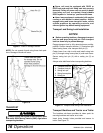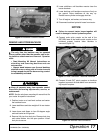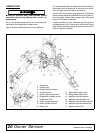
14 Operation
MAN0306 (Rev. 5/23/2008)
After becoming familiar with the backhoe operation,
practice coordinated use of the controls in a safe open
area at reduced engine speed. Gradually increase
engine speed as the technique is mastered.
Operate backhoe gently and smoothly. Avoid swinging
boom into mainframe. Sudden stopping or jerking
could result in serious damage to tractor and backhoe.
Strive to develop a smooth digging cycle. Avoid abrupt
or jerky movements. This is accomplished by operating
two or more controls at the same time and not allowing
the cylinders to reach the limit of travel.
Should you become confused during operation, simply
let go of the controls. The valve control handles will
automatically return to neutral.
START EXCAVATION
Consult local utilities before working. Know
location of all underground cables, pipelines, over-
head wires, and other hazards in working area and
avoid contact.
To start the excavation, position backhoe as shown for
maximum breakout force.
Actuate the dipperstick cylinder to start digging.
Approximately halfway through digging cycle, start
bucket curl while continuing to crowd dipperstick in.
Should bucket stall, raise boom slightly.
Do not use down pressure on the boom when starting
to dig, as this will lift the machine and move it out of
alignment with the work.
Figure 3. Starting Position
FILL BUCKET
Control bucket attitude throughout digging cycle to
keep teeth parallel to bottom of excavation. This will
provide best penetration angle and minimize dragging
and scraping bucket through the ground.
Penetration depth is determined by soil condition and
type.
Only use dipperstick and bucket during the digging
cycle. As the dipperstick moves the bucket through the
soil, curl bucket to maintain proper bucket position.
At the end of the pass, or when bucket is full, curl
bucket completely, lift bucket from excavation and
swing boom to dump site.
To obtain a cleaner trench and avoid material buildup
directly in front of backhoe, extend dipperstick and curl
bucket completely while starting to lift it out of the exca-
vation. This will allow excess material to fall back into
the excavation.
Figure 4. Fill Bucket
DUMP AND RETURN CYCLE
Keep the swing-dump-return cycle as brief as possible.
Keep dipperstick moving outward and start boom swing
as soon as the bucket clears the excavation. Continue
extending dipperstick and, as you approach the spoil
pile, start to dump bucket.
When bucket is empty, dipperstick and bucket are in
position to resume digging upon return to the excava-
tion.
TRENCHING AND EXCAVATING
Refer to Figure 5.
Trenching is the most basic backhoe digging operation.
Other operations are variations of this basic function.
To maintain a level trench bottom, set bucket at proper
approach angle and while crowding dipper-stick in,
continually move bucket curl lever to maintain correct
cutting angle. At the same time, place boom control in
the full forward (float) position and keep the bucket in
the same plane.
When handle is placed in the float position, pressure
on both sides of boom cylinder is released.
Digging near center of swing so material may be
dumped on either side will produce good results. Never
dig near stabilizers.
Continue the trench by moving machine along trench
centerline away from existing excavation. Move
machine approximately one-half the effective backhoe
reach. Moving too far will require excessive down pres-
sure for digging and hand clean-up of trench bottom.


















